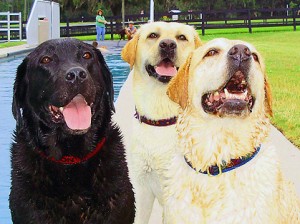Canine Physical Therapy & Rehabilitation
When our Bouvier, Garrison, suffered from a double FCE (Fibrocartilaginous Embolism), the neurologist told us that if he were ever to walk again, it would require lots of physical therapy. Another colleague of ours whose husband is a vet called to share with us that he is performing groundbreaking stem cell therapy that could also help our dog regain mobility. We had options, neither of which would be inexpensive nor would they be a guarantee.
The morning after the initial injury while awaiting a phone call from our neurologist with a status update, I did an internet search for “canine physical therapy and rehabilitation in Los Angeles”. The facility Two Hands Four Paws in Santa Monica came up at the top of the list. I clicked on their website and read about their staff, facility, and therapy options. Before I gave them a call, two other colleagues sent me private messages about “this facility in Santa Monica called Two Hands Four Paws” that had helped their dogs. I decided to make an appointment for Garrison, knowing that we could always cancel if need be. When I finally spoke with our neurologist, she said we should start therapy right away. “There is a facility in Santa Monica,” she said, and I informed her I had already made the first available appointment.
Four days post-injury, my husband and I drove our boy to Two Hands Four Paws. A friend who had recently put me in touch with a colleague of hers whose Belgian Tervuren had suffered from the same symptoms and learned to walk again four months later, met us there. She was heartbroken by Garrison’s injury, encouraged because of her colleague’s dog’s eventual recovery, and intrigued as to what the facility might offer to satisfy her own curiosity. We were thankful to have her there.
We all met with the founder, Leslie McMahon, one of the physical therapists, Melissa, and the supervising vet, Dr. Jonit Barsky. The three of them went over Garrison to assess his current physical and mental condition. We shared the story of his injury, his neurology report, and his overall daily lifestyle. We showed a video of him playing ball in the front yard so they could get an idea of his activity the day he was injured as well as his physical strength and mobility prior to his injury. Dr. Barsky immediately went to work measuring all his angles, flexibility, neurological responses, and commented that he was in such excellent shape with great muscle tone, it could be one of his best assets to help him recover more quickly. Melissa immediately started massaging his body to assess tight muscles and soreness and, to no surprise, discovered very stiff shoulders and neck due to him doing “handstands” for four days. The recommendation was to be as aggressive as we could manage financially and time-wise using hydrotherapy, supplemented with acupuncture and occasional laser therapy.
During these initial conversations, we found out that one of Leslie’s regular jogging partners worked in a laboratory at UCLA that dealt with spinal injuries and treatments. It was funded by the late Christopher Reeves. Through these studies, scientists discovered that a dog with a severed spine could regain mobility and, most importantly, that it requires a minimum of 750 repetitive motions of a limb before the rebuilding nerves will find a path around dead nerve cells to connect with the brain to recognize there is, indeed, a limb needing movement. The team at Two Hands Four Paws said with confidence that he would walk again some day. This confidence, along with their combined skillsets, gave us our first real glimmer of hope, and Garrison went to work.
We had our first experience with the aqua treadmill that day. A fully enclosed treadmill, warm water rises up from the floor to the desired height, which reduces the load on painful joints, relaxes muscles, adds resistance to specific muscle groups, and improves overall core stability. Garrison had a PVC pipe through the handles of his harness to hold up his rear. Leslie sat behind him and gently and slowly patterned his rear legs as if they were walking while Garrison struggled to understand his front end’s resistance in the water and this overall new experience. After three sessions lasting a minute-and-a-half each, we toweled him off, put him back in an exam room, and iced the injured athlete down. He was tired – both physically and mentally.
We left that day with a folder of materials and multiple pages of physical and neurological retraining exercises. We had our work cut out for us in between therapy visits. This was a whole new world to us, too. As we drove home, we felt we had a great plan of therapy treatments for our dog. Now we had to trust that time, love, and a whole lot of effort would give him a fighting chance to eventually live as normal a lifestyle as possible down the road.
Short URL: http://caninechronicle.com/?p=53485
Comments are closed












